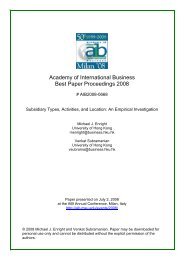AIB 2012 Conference Proceedings - Academy of International ...
AIB 2012 Conference Proceedings - Academy of International ...
AIB 2012 Conference Proceedings - Academy of International ...
You also want an ePaper? Increase the reach of your titles
YUMPU automatically turns print PDFs into web optimized ePapers that Google loves.
MONDAY<br />
Do the Biggest Aisles Serve a Brighter Future Global Retail Chains and Their Implications for Romania<br />
Yue Li, World Bank<br />
Beata Javorcik, University <strong>of</strong> Oxford and CEPR<br />
During the past two decades many countries have opened their retail sector to foreign direct investment, yet<br />
little is known about the implications <strong>of</strong> such liberalization for the economies <strong>of</strong> host countries. Using a unique<br />
dataset combining outlet-specific information on global retail chains with a panel <strong>of</strong> Romanian manufacturing<br />
firms, this study sheds some light on this question. The results from the difference-in-difference analysis<br />
suggest that the expansion <strong>of</strong> global retail chains led to a significant increase in the total factor productivity in<br />
the supplying industries. Their presence in a region raised the total factor productivity <strong>of</strong> firms in the supplying<br />
industries by 3.8 to 4.7 percent, while doubling the number <strong>of</strong> chains led to an increase <strong>of</strong> 3.3 to 3.7 percent.<br />
The conclusions are robust to a variety <strong>of</strong> specifications and supported by the survey evidence. These findings<br />
suggest that the opening <strong>of</strong> the retail sector to foreign direct investment may stimulate productivity growth in<br />
manufacturing industries through backward linkages, and they provide another piece <strong>of</strong> evidence in favor <strong>of</strong><br />
services liberalization. (For more information, please contact: Yue Li, World Bank, USA: yli7@worldbank.org)<br />
Bi-Directional Technology Spillovers between Foreign and Local Firms: Empirical Evidence from an Emerging<br />
Economy<br />
Gerald Yong Gao, University <strong>of</strong> Missouri-St. Louis<br />
Yao Amber Li, Hong Kong University <strong>of</strong> Science and Technology<br />
Min Ju, University <strong>of</strong> Missouri-St. Louis<br />
We examine the bi-directional technology spillovers between foreign and local firms. Extending the literature <strong>of</strong><br />
FDI spillovers, we focus on new product development as the non-productivity spillovers outcome and further<br />
investigate the possible reverse spillovers effect from local to foreign firms. Moreover, we test whether the<br />
effect <strong>of</strong> technology spillovers is contingent on firm geography. Based on a seven-year panel data <strong>of</strong><br />
manufacturing firms in China, we find strong evidence <strong>of</strong> the two-way technology spillovers. Interestingly,<br />
geographic proximity positively moderates the technology spillovers from foreign on local firms, but it has no<br />
effect on local firms' spillovers on foreign firms. (For more information, please contact: Gerald Yong Gao,<br />
University <strong>of</strong> Missouri-St. Louis, USA: gaogy@umsl.edu)<br />
A Non-Linear Model <strong>of</strong> Technological Spillovers from Foreign Direct Investment (FDI): A Comparison between<br />
Horizontal and Vertical Spillovers<br />
Yoo Jung Ha, University <strong>of</strong> Manchester<br />
Axèle Giroud, University <strong>of</strong> Manchester<br />
This research investigates the non-linear form <strong>of</strong> backward and forward spillovers. To our knowledge, we<br />
present the first findings about the non-linear relationship <strong>of</strong> backward and forward spillovers with local firm<br />
performance. We demonstrate that the relationship <strong>of</strong> horizontal spillovers and backward spillovers with local<br />
firm performance occurs in an inverted-U shape, respectively. Forward spillovers are positive overall and marked<br />
by a constant marginal rate <strong>of</strong> incidence, and thus occurring almost proportionately with rising inward MNE<br />
investments. Based on empirical evidences, we propose a conceptual model where factors <strong>of</strong> curvilinear learning<br />
curve are fixed costs and marginal costs <strong>of</strong> learning. In other words, backward spillovers are underscored by<br />
low fixed costs and rising marginal costs <strong>of</strong> learning, while forward spillovers are underscored by relatively high<br />
fixed costs and constant marginal costs <strong>of</strong> learning. (For more information, please contact: Yoo Jung Ha,<br />
University <strong>of</strong> Manchester, United Kingdom: y.j.ha@sant.oxon.org)<br />
<strong>AIB</strong> <strong>2012</strong> <strong>Conference</strong> <strong>Proceedings</strong><br />
Page 185

















